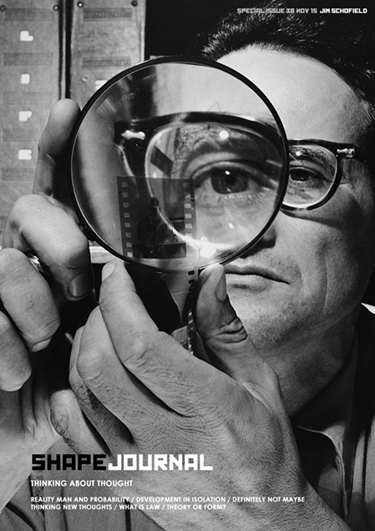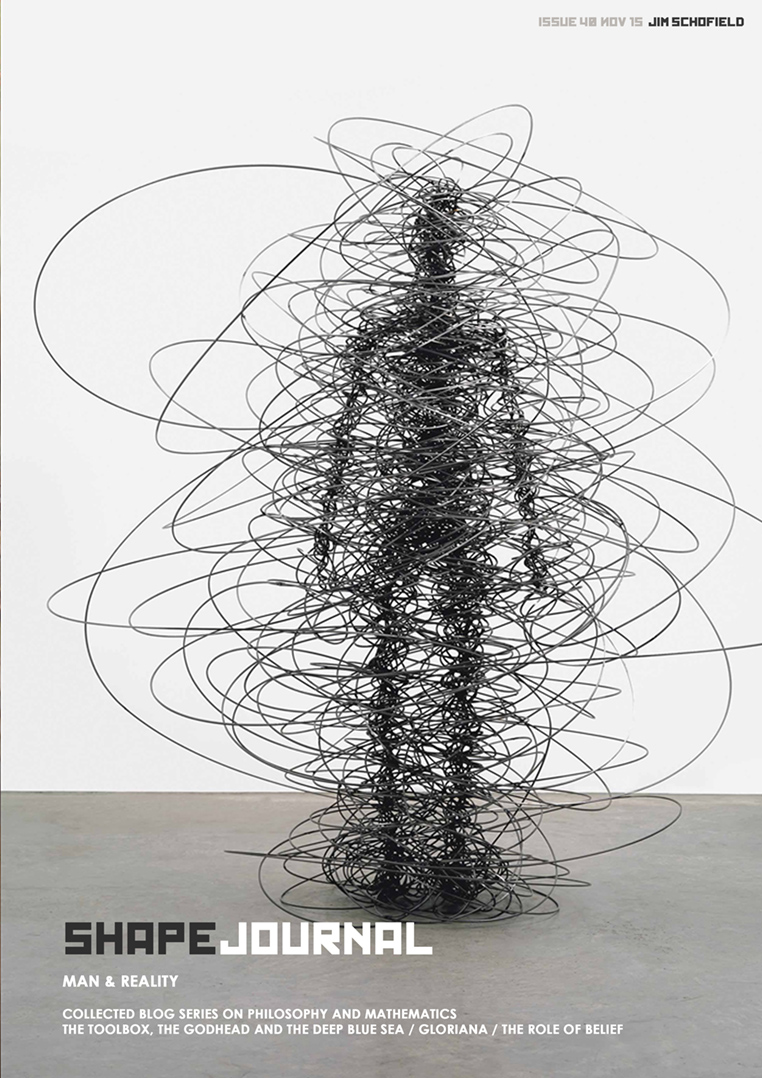 |
| Halo Rose - Bauhaus - Selbstportrait |
The Self-imposed Limits of Human Thinking
When attempting to understand Reality, Mankind is always presented with an extremely puzzling set of apparently ubiquitous features, which seem to continually undermine such efforts. And, these problems usually stem from two sources.
The first is the complex, confusing and sometimes seemingly contradictory Nature of Reality itself. And, the second, as you have no doubt already guessed, is the Nature of Mankind itself.
You wouldn’t think that such would be the case, seeing as Man was created by, and is certainly a part of Reality, but, nevertheless, it is quite definitely so! Reality is not only incredibly complex, but it is also creative: it not only develops in complexity, but also, and crucially, it evolves, regularly, delivering wholly new and unique creations, and the only tool for revealing that nature is its own remarkable product of Evolution – Man himself!
Now, this paper will not be some dazzling literary effort, designed, expressly, to both entertain and beguile the reader, but, instead, is an important and informative attempt to inform that person, both about himself, and also the unavoidable diversions that Mankind inevitably takes in his efforts to make sense of his world.
And, most important in such a task, have to be the conditions that Mankind had to cope with, and which played a crucial formative role in his thinking. For they certainly made him, and developed him in ways appropriate to his means of life. And, that means that Mankind would be congenitally, ill-equipped by Natural Selection to undertake the quite different task of understanding things, and, consequently, of being able to explain them. Man was selected-for, throughout the vast majority of his existence, to be a hunter/gatherer, requiring very different mental processes to today. By the time he had turned to further paths, the forces of Natural Selection, and gene adaption, were over.
Man could NOT depend on his “appropriate genetic makeup” in dealing with the new problems he had begun to set himself. The usual forces of evolution no longer worked to equip Man in his new roles. Man had somehow, to do it for himself!
And, it has to be said that this has by no means been straightforward. Indeed, the forces of Natural Selection are never principled or planned, but entirely pragmatic – “If it works, it is right!” To this day it is the most important element in Man’s nature, and particularly in his thinking.
He is the epitome of pragmatism. And, the application of his undoubtedly superior intelligence is inevitably directed by this. He solves problems pragmatically, and often brilliantly, and clearly does it much better than all other known animals.
Now, that isn’t to say that Man, or at least some among his species, did not turn to tackling other questions. But, because of his nature, involving both his intelligence and his pragmatism, progress was neither direct nor easy. Indeed, though he found many physical pragmatic solutions to aid him, his explanations were, initially at least, very wide of the mark!
To begin to have any chance of doing that, he had to massage Reality in order to get any kind of a handle upon it. He just had to simplify it – ignoring all anomalies, and concentrate upon subsets that seemed to conform to extractable forms. The consequences, as you would imagine, were “temporarily useful”, but ONLY in chosen conditions. In the short term they could be pragmatically useful, but in the long term were bound to fail.
He had begun to make “conceptual bricks”, but they could only build the most flimsy of “explanatory erections”.
Indeed, Man was constantly prevented, by his own self-devised methods, or of getting a general grip upon Reality – for though encouraged by the successes he achieved, he was also bewildered by their failures, and the seeming contradictions that always came up. Of course, it isn’t easy “pulling yourself up by your own bootlaces”!
Let us be clear. Mankind initially made very slow progress for the vast majority of his existence as a separate species: yet modern man is exactly the same animal. That slow progress was not because he was unintelligent, but because he was too pragmatic: there just had to be a revolution in how he Thought! No recent new endowment has enabled his recent enormous developments, and his selected-for abilities, which were prodigious as a hunter/gatherer, but useless as a philosopher – as a thinker about himself and his World.
But, he did begin to re-invent himself, to a degree, by using his undoubted intelligence in new ways. What were essential for his future success, included thinking that could be adapted to other tasks, and perhaps the most helpful were ideas about Religion. Explanations could be put down to an all-powerful deity “on our side”, and such made the achievement of remarkable, and energising, common purposes in believers.
Of course, there were other crucial changes in his mode of life, which were vital in generating new thinking. The so-called Neolithic Revolution, wherein the cultivation of crops, and the rise of animal husbandry, allowed groups of human beings to not only stay where they were, but also to do it with other families. Then larger groups, and more diverse discussions, especially in a new or better way of life, were the trigger for a great deal of new thinking.
But, to see how he got to where he is now, and how he could go forward from here, he will certainly have to understand himself – what he presently does, how he thinks about, and what he must do to progress further.
For, the crises and impasses, in his understanding are by no means over yet. Without another, major revolution in his current thinking, he will grind to yet another crucial halt.
We must bury forever the myth that amassing knowledge will be sufficient. What must also be developed is Understanding - knowing
why.
And, that must be applied not only to the Reality he confronts, but also to himself!
Around 2,500 years ago, two new trends in thinking appeared, which have been crucial in the developments that Man has made in understanding his World. But, they seem to be mutually exclusive alternatives.
In Greece, the rationalist or reason-directed way of thinking – based upon the Principle of Plurality was established, and led to both Geometry and Formal Logic. Though, crucially, this naturally led to the assumption of eternal Natural Laws, which then summed to produce all consequent productions and behaviours. Such a stance meant that Reality was everywhere just a complication of unchanging Laws.
Meanwhile, in India, the philosophical methods of the Buddha took things in a very different direction, by conceiving that “everything affects everything else” – based upon the Principle of Holism.
Clearly, these two approaches were totally incompatible, as presented, and different cultures chose one or the other exclusively. These were, clearly, opposite to one another in many important ways, yet BOTH contained some aspects of the truth of situations – what we have come to call Objective Content. Neither was sufficient in itself, but, nevertheless, which led to significant progress in thinking – though each only in its own self-defined contexts. And, progress in either of these routes was compromised by Mankind’s built-in pragmatism, which crucially meant that Man could keep all that he found - including contradictory pairs of concepts, and could merely switch between alternatives, pragmatically, until he found the one that best fitted the given situation.
Now, though this pragmatic approach did, indeed, lead to the solving of many problems, it was anathema to the requirement of developing consistent, coherent and comprehensive understanding. It was very damaging indeed!
Now, worshippers of Logic, or even Science, will vigorously disagree, but I’m afraid that they will be wrong. Let us take the supposed “God of Understanding”, namely Logic, and see how that holds up.
 |
| Rodchenko |
It was, of course, the achievement of the Greeks, and was, without doubt, both a brilliant and an essential development. But, it was only made possible by a strict and vigorous filtering of Reality in order to reveal its essences. In other words, Reality was NOT dealt with “as is”, but was processed by both simplification and idealisation to highlight certain then extractable features, which could then be directly investigated in their own terms alone, to attempt to formulate explanations of the phenomena involved.
This expression – “in their own terms alone” is crucial. For it took, what seemed to be, permanent features and assumed that they were always the same – whatever the context would be.
The expression, “The Greeks had a name for it” encapsulates this approach very well. For, by affixing a name, it made the named thing a “constant” component – as if naming it said what it was, and therefore how it would dependably behave. [You know what I mean – if someone can stick a label upon what you are, they assume they have a reliable handle on how you will behave: it is a very ancient “wisdom”]. And, of course, over a quite extended period, such a simplification would indeed suffice!
NOTE: To this day, there are those who will correct your attempts to explain something, with the interjection – “Oh, you mean colloquialism” (or some such contribution), assuming that the name, in Greek or Latin, for a phenomenon - inferring that its meaning is fully encapsulated in that name. It isn’t!
It showed itself constantly, for example, in the belief that all animal or plant species were immutable, and could not change into something else!
And, perhaps the epitome of this approach resides indubitably, in Mathematics – particularly in that lauded Greek achievement of Euclidian Geometry, where, at its very heart were Numbers which, by definition in “Counting”, cannot be but totally fixed. Indeed, Number is often the target, and essence, of simplification and the idea of eternal, unchanging things to be studied in the “fixed” terms alone!
But, in addition, the essential founding principle of such an approach can ONLY be that of Plurality! And, this is because, that Principle rejects evolutionary changes, and even developing Laws. And, it explains all differences in terms of various additive mixes of producing fixed components.
It led, inexorably, to the concept of Eternal Laws, on the one hand, considered incremental additional quantities as solely delivering emerging Quality, on the other. Formal Logic is entirely pluralistic!
Now, earlier in this paper, I compared Plurality with that of Holism – the stance of the Buddha, both of which originated at about 500 B.C. And, it was immediately clear that these stances could not be more contradictory!
The Constants, appearing in pluralist equations of phenomena, were the very same things as the ever-changing factors, of a holistic explanation. Clearly, one stance built the World ultimately out of fundamental eternals, while the other saw it as an evolution of components to ever new entities, properties, laws and Levels.
Now, posed like this, it is clear that the choice of Plurality – dominating for 2,300 years, and is still in charge today, and appears to be indisputable! Yet, Darwin’s Origin of Species was unavoidably holistic, as was Fred Hoyle’s Theory of the Evolution of Stars. And, we should not leave out Stanley Miller’s experimental investigation into the Origin of Life itself.
Even Yves Couder’s brilliant “Walker” Experiments, while not only completely holistic, for the first time breeched the Copenhagen dominance in Sub Atomic Physics.
Clearly, Holism had something crucial to offer.
And, believe it or not a holist stance has long been woven into Science - even though it seemingly arose entirely out of Plurality. Quite apart from the objective of finding formulateable pluralist laws, the equally important search for theoretical explanations of phenomena could never be delivered, materialistically, from mere formal descriptions. And, the only way to seek out such aspects of Reality had to be finding Causes in terms of entities and their evident properties – such clear materialistic incentives forced an alternative route to accompany the pluralist one. And, as it was also always extending the generality of things to ever wider areas, the particular limitations of pluralist relations, very quickly proved inadequate. Coherence, Consistency and comprehensiveness forced Theory into a holistic stance.
A dichotomous pair of contradictory stances grew up alongside one another, without, necessarily, blowing Science apart. A switching of ground (a very pragmatic method) managed to allow a surprising, yet fruitful marriage!
And, hence, perhaps less surprisingly, a third distinct stance arose within Science and grew in strength all the time. WE would call it Pragmatism, except that it was, to an extent, limited to the achievements of Science alone, where it was about effective use of the achievements of Science, and became known as Technology!
The practitioners involved, who came to be called Engineers, did not have to discover, but they had to successfully use the Laws of Science in productive ways!




















